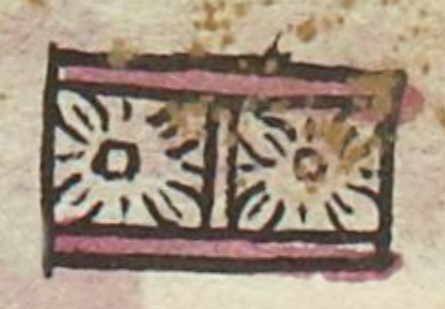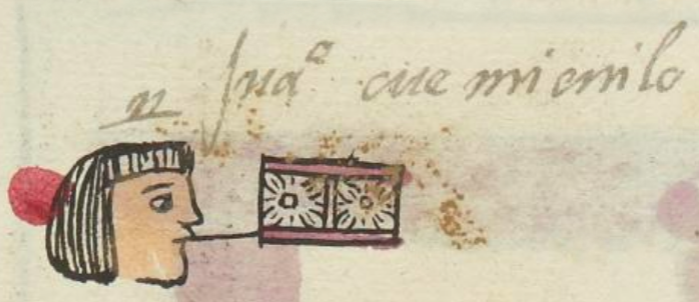Cuemicuilo (MH514r)
This simplex glyph for the personal name Cuemicuilo shows a rectangle, perhaps meant to represent a cuemitl, or agricultural field. Inside the rectangle, which is outlined in red on the top and bottom, are two sections, each containing a quincunx, a flower-like shape with a circle in the middle.
Stephanie Wood
The rectangle with this symbol is often meant to represent a codex or a book, and the symbols inside indicate writing. See, below, some other examples. The reading of cuemitl as an agricultural field deserves further thought. Are the flowers growing in the field symbolic of a paper with writing or perhaps with a stone carving?
Marc Thouvenot identifies the verb icuiloa (or ihcuiloa, with the glottal stop), which means to paint, write, or print, as having a root of -cuil-. He notes how it also appears in tlacuiloliztli (writing), tlacuilo (writer), and cuicuiltic (mottled). He goes on to show various uses of icuiloa that take it beyond the simple definitions just given, resulting in something like the action of creating a design (e.g., on leather, ceramics, sculpture, or in textiles). It can also be something like the action of decorating (e.g., to put a flower on a cup of atole). He associates icuiloa and tlacuilolli with "cultural artifacts," such as arts and crafts or examples of writing and painting, but cuicuiltic with effects created by "nature." This short summary barely does his article justice; it is worth reading the entire piece. How Thouvenot's study might connect with the concept of bent or curved mentioned by Prem (1974: 555, 682) raises an interesting question. Perhaps the bent or curved lines of writing, painting, carving, embroidery, and so on, fall with in the realm of expressions of -cuil-. See
Marc Thouvenot, "Imágenes y escritura entre los nahuas del inicio del XVI," Estudios de Cultural Náhuatl 41 (2010).
Stephanie Wood
Juao cuemicuilo
Juan Cuemicuilo
Stephanie Wood
1560
Jeff Haskett-Wood

cuemi(tl), agricultural strip, https://nahuatl.wired-humanities.org/content/cuemitl
quemi(tl), ritual bib, https://nahuatl.wired-humanities.org/content/quemitl
icuiloa, to paint/write, https://nahuatl.wired-humanities.org/content/icuiloa
Matrícula de Huexotzinco, folio 514r, World Digital Library, https://www.loc.gov/resource/gdcwdl.wdl_15282/?sp=107&st=image
This manuscript is hosted by the Library of Congress and the World Digital Library; used here with the Creative Commons, “Attribution-NonCommercial-ShareAlike 3.0 License” (CC-BY-NC-SAq 3.0).










